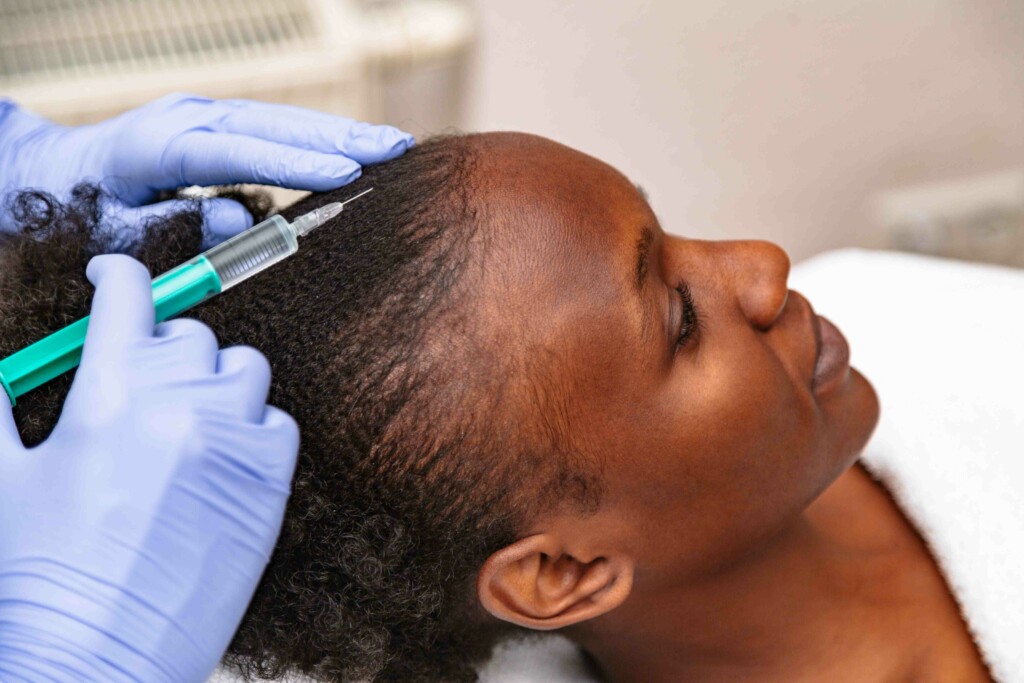Pyrilutamide, also known as KX-826, is a topical androgen receptor-blocking drug being developed by Kintor Pharmaceutical Ltd. for the treatment of pattern hair loss (androgenetic alopecia). Pyrilutamide has successfully completed phase II clinical trials in men in China. It’s currently being studied in clinical trials for both men and women in China and men in the United States. (1)
Additionally, Kintor’s hair loss drug is also being explored as a treatment for acne vulgaris. The use of pyrilutamide as a treatment for acne vulgaris is still in the preclinical stage in the United States, but it’s already started phase II clinical trials in China.
How Does Pyrilutamide Work for Hair Loss?
Androgen receptor blockers like pyrilutamide are a bit like the oral dihydrotestosterone (DHT) blockers finasteride and dutasteride. However, these DHT-blocking pills work by targeting the 5-α-reductase enzyme that converts testosterone into DHT. Pyrilutamide works by targeting the androgen receptor itself. (2)
Ultimately, though, the end goal is the same. Whether you’re using finasteride, dutasteride, or pyrilutamide, DHT — the main hormone involved in the progression of pattern baldness — is blocked, which helps improve hair loss and stops future hair loss.
Current Pyrilutamide Clinical Trials (Updated July 2023)
At the moment, Kintor is running two clinical trials. The first is a phase III clinical trial testing pyrilutamide for the treatment of male androgenetic alopecia in China. The second is a phase III long-term safety trial for the treatment of androgenetic alopecia in men and women. (10,11)
Kintor previously completed a phase II clinical trial in China for women with androgenetic alopecia, a phase II clinical trial in China for men with androgenetic alopecia, and a phase II clinical trial in the USA for men with androgenetic alopecia. Kintor is also in the process of testing pyrilutamide as an acne treatment. It’s currently in clinical trials in China for this indication, and is exploring starting clinical trials in the USA in the near future. (1)
The Latest Pyrilutamide Results
In September 2021, Kintor announced that the Chinese phase II pyrilutamide clinical trial for men with androgenic alopecia had been successful, demonstrating good efficacy and safety. However, since then, no results have been published in scientific journals. The only publicly available results are on Kintor’s website and internally created presentations, or conference results. (1,4-6)
The most detailed pyrilutamide clinical trial results currently available come from press releases and a poster created for the Annual Meeting of the Chinese Hair Research Society sponsored by the Chinese Society of Dermatology. According to this poster presentation, 120 Chinese men with moderate pattern hair loss symptoms (Norwood-Hamilton classification IIIv, IV, or V) enrolled in this phase II clinical trial.
Three different options (and two controls) were tested during this clinical trial:
- Pyrilutamide 2.5 milligrams (0.25% concentration) applied twice daily
- Pyrilutamide 5 milligrams (0.5% concentration) applied once daily
- Pyrilutamide 5 milligrams (0.5% concentration) applied twice daily
The study reported that applying 5 milligrams of pyrilutamide twice a day produced the best improvements in hair growth, increasing hair count by 22.73 hairs per cm² after 24 weeks of treatment. In comparison to the placebo group’s hair count, the twice-a-day 0.5% concentration of pyrilutamide increased hair counts by 15.34 hairs per cm². (4-6)
Since then, Kintor has released several other press releases stating the details of its results. Both its female phase II pyrilutamide clinical trial and its American phase II pyrilutamide trial for male pattern hair loss showed promising results.
Pyrilutamide Side Effects
The latest pyrilutamide clinical trial results confirm the positive safety results associated with the use of Kintor’s hair loss drug, showing a lack of serious adverse reactions. Users reported only mild side effects limited to issues such as itchy, dry skin, redness and irritation, and contact dermatitis. (4-6)
Notably, these safety results are also in line with those from the previous Phase I/Ib clinical trial results for pyrilutamide, which reported that all side effects were related to contact dermatitis. It is unclear if this side effect is due to the drug itself or to the solution used to deliver the drug – which is a common issue with other topical medications, like liquid minoxidil.
As an androgen receptor blocker, pyrilutamide has the potential to have much more serious side effects – such as those produced by oral finasteride and oral dutasteride. The severity of these systemic side effects is partially due to the way these drugs build up in the bloodstream. The pyrilutamide phase II clinical trial was also able to show that the daily repeated application of this topical medication did not cause the same type of build-up of this medication in the bloodstream, which means that similar systemic side effects are unlikely, even with long-term use. (7)
Future Pyrilutamide Clinical Trials
Based on the results of the previous clinical trial, future pyrilutamide clinical trials in men with androgenic alopecia will likely exclusively proceed with the application of 5 milligrams of pyrilutamide twice a day, while those for women will likely use 5 milligrams of pyrilutamide once a day. It is not yet known which dose is being used on the men and women participating in the long-term pyrilutamide safety study, or if these results will have any bearing on the dose tested for upcoming acne vulgaris pyrilutamide trials.
The current Kintor pyrilutamide phase III clinical trial for male androgenic alopecia will last for 24 weeks (with an additional 4 week safety component) and has enrolled a total of 740 men. Results are expected around the end of 2023. The long-term safety study of pyrilutamide just started recruiting participants in Q3 2023, and is likely to continue recruitment for the next few months. There is not yet a forecasted release date for the results of this clinical trial. (4-6, 10, 11)
Joining a Pyrilutamide Clinical Trial
Right now, joining a pyrilutamide clinical trial is highly unlikely as enrollment for men in the United States and women in China are currently closed. You’d only be considered as a participant if you were a man with moderate pattern hair loss symptoms living in China.
But if you’re interested in trying a hair loss treatment, you can consider oral DHT blockers like finasteride or topical treatments like minoxidil. Minoxidil is FDA-approved as a treatment for both male and female pattern hair loss, while finasteride is only approved for male pattern hair loss. (2)
You can also check out upcoming clinical trials for other novel hair loss treatments. For example, Kintor is currently running clinical trials on another androgenic alopecia drug, GT20029, that works as an androgen receptor degrader. And Cassiopea, an Italian pharmaceutical company, is starting phase III clinical trials on its own androgen receptor blocker, Breezula®, in the near future. (1,9)
References
- Product Pipeline. Kintor Pharmaceutical Limited. (n.d.). Kintor.
- Dominguez‐Santas M, Diaz‐Guimaraens B, Saceda‐Corralo D, Hermosa‐Gelbard A, Muñoz‐Moreno Arrones O, Pindado‐Ortega C, Fernandez‐Nieto D, Jimenez‐Cauhe J, Ortega‐Quijano D, Suarez‐Valle A, Jaen‐Olasolo P. (2022). The state‐of‐the‐art in the management of androgenetic alopecia: A review of new therapies and treatment algorithms. JEADV Clinical Practice.
- Kintor Pharma: Developing Novel Drugs and Commercialization Platform (2022) Kintor.
- EQS Newswire. (2022, August 30). Kintor 2022 interim results: Pruxelutamide and KX-826 show positive results, business value has been presented. Bloomberg.com. Retrieved October 1, 2022.
- Poster: Phase II clinical trial to evaluate the safety and efficacy of frittan (KX-826) tincture in the treatment of androgenetic alopecia (AGA) in Chinese adult males (KX-826-CN-1002). (2022). Kintor.
- Pharma, K. (2022, August 3). KINTOR Pharma announces completion of patient enrollment in phase II clinical trial of KX-826 for treatment of Androgenetic Alopecia in the US. Kintor Pharma Announces Completion of Patient Enrollment in Phase II Clinical Trial of KX-826 for Treatment of Androgenetic Alopecia in the US. Retrieved October 1, 2022.
- Hirshburg, J. M., Kelsey, P. A., Therrien, C. A., Gavino, A. C., & Reichenberg, J. S. (2016). Adverse effects and safety of 5-alpha reductase inhibitors (finasteride, dutasteride): a systematic review. The Journal of clinical and aesthetic dermatology, 9(7), 56.
- Kinter, K. J., & Anekar, A. A. (2022). Biochemistry, dihydrotestosterone. In StatPearls [Internet]. StatPearls Publishing.
- Home Page. (2020, August 27). Cassiopea.
- PR Newswire. (2023, 28 March) Kintor Pharma Announces Completion of Subject Enrollment in Phase III Clinical Trial of KX-826 for Treatment of Male Androgenetic Alopecia in China. Bloomberg.com.
- Kintor Pharma Announces Completion of First Patient Enrollment in KX-826 Long-term Safety Phase III Trial for Treatment of AGA (2023, 19 July). Kintor.
Last updated July 2023




